
Page 30
http://threesology.org
Note: the contents of this page as well as those which precede and follow, must be read as a continuation and/or overlap in order that the continuity about a relationship to/with the typical dichotomous assignment of Artificial Intelligence (such as the usage of zeros and ones used in computer programming) as well as the dichotomous arrangement of the idea that one could possibly talk seriously about peace from a different perspective... will not be lost (such as war being frequently used to describe an absence of peace and vice-versa). However, if your mind is prone to being distracted by timed or untimed commercialization (such as that seen in various types of American-based television, radio, news media and magazine publishing... not to mention the average classroom which carries over into the everyday workplace), you may be unable to sustain prolonged exposures to divergent ideas about a singular topic without becoming confused, unless the information is provided in a very simplistic manner.
Let's follow-up with the Counting-out rhyme information displayed at the bottom of pageAI&3sology pg28. And for those readers who are not comprehending the need for looking into the historical deep past as well as linguists of different age groups, let it be explained that Artificial Intelligence systems will be like the training of children. However, the need for developing the role of infancy in terms of reflexes and instincts will also come into play as AI systems progress into complex entities... if they are to reflect an adaptive biological-based nature.
There are various counting rhymes such as those which aid in the learning of numbers, those which very often deal with inclusion or exclusion, and those which allow for flexibility. For example, a "learning numbers" rhyme would be:
One, two, buckle my shoe
Three, four, shut the door
Five, six, pick up sticks
Seven, eight, lay them straight
Nine, ten, a big fat hen...
Please note the usage of a binary sequence, and a three-part ordering of each line; involving two numbers and then some object. (For example: "One- Two- Shoe"). And also note that while their may be individual circumstances where a "Eleven, Twelve" may be followed by some (possibly made-up) word that rhymes with "twelve", there typically is no continuance into larger numbers. Hence, we see an example of the conservation of number.
As for a number or counting rhyme that deals with inclusion, let us consider the "Eeny, Meeny, Miney, Moe" variety. In this particular formula, we see there are three rhymes to one non-rhyme, providing us with a 3-to-1 ratio... examples of which are to be found on page: AI&3sology pg16:
Eeny, Meeny, Miney, Moe...
Catch a Nigger by the toe...
If he hollars, let him go...
My mother told me to pick the very best one...
Please note that there are three ending rhymes (Mo- Toe- Go), with one ending that is not. Again, this is a 3-to-1 ratio.
As for an example of flexibility related to inclusion or exclusion, we find the following rhyme:
One potato, two potato, three potato... four (there is no "four potato")
Five potato, six potato, seven potato... more (there is no rhyme and no "more potato")
The person selected as the "more" candidate is either included or excluded. Notice also that each line represents a 3-to-1 ratio.
In the following variety, there is a counting sequence expressed in the overall design, even if the users are not cognizant of it:
Happy Birthday to you
Happy Birthday to you
Happy Birthday dear .......
Happy Birthday to you.
The third line is used as a special reference, though a 3-to-1 ratio is preserved (conserved) by the three times repetitive usage of "Happy Birthday to you".
When we look at the development of counting systems amongst adults from different cultures, we find... as has already been noted, there is the usage of a language equivalent "one" to the quantity of "1", the word "two" for the quantity "2", and a word such as "many" to describe all quantities beyond 2. In other words, there is a cognitively exercised conservation of number in adults just as there is in children and infants. However, I do not know if a deliberate attempt to increase the pattern formula or increase the complexity in infant babbling and the utterances of children, will increase the values and complexity in adults... since we adults are subjected to the infantile and childish patterns used by businesses (such as advertisements, product details, etc.), governments (governing structures, laws, taxation standards, etc.) and religions (judgments based on simplistic binary patterns such as heaven/hell, good/bad, right/wrong, etc.); which amount to primitive survival mechanisms.
Here's another counting scheme that is sometimes used to synchronize action or activity amongst two or more... like the synchronization which can occur amongst circuitry:
One for the money,
Two for the show,
Three to get ready,
and Four to go.
The three number words occur first in their respective lines and "Four" comes after the partitioning word "and", much in the manner that the "comma" does when separating hundreds from thousands. Again, we have a three-to-one ratio layered in counting, rhymes and words.
Here's another variety used as a means of attributing quality to counting, though it is a specific pattern-of-three:
First is worst (such as when winning),
Second's the same,
Third (or last) is best in any game.
In adulthood, we turn to giving numbers to the first three bases in baseball, but the so-called "forth" base is most typically referred to with a non-number label such as Home base or Home plate. Another adult application is to refer to the first three downs in football as running or passing events, while the fourth down is given the additional option of punting. In the venues of adult Olympic's games we find three medals (Gold- Silver- Bronze) and horse racing uses a Win-Place-Show (as well as Trifecta) betting scheme, though a "daily double" of some sort might be added to the racing atmosphere. As for playing the card game of poker:
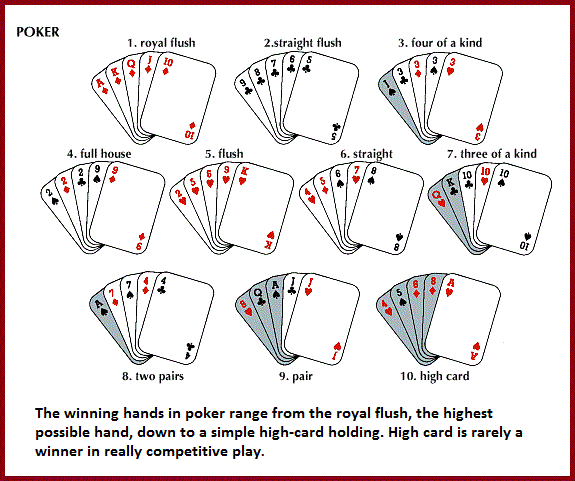
Again and again we see a conservation of number. In other words, the game is constructed as an exercise in cognitive conservation, but the playing antics results in "wins" that are marvelled at by both players and observers who share in the same type of cognitive conservation orientation. However, regardless of how many examples of number conservation I supply, most readers are quite possibly overlooking the situation that the types of conservation of number we are engage in, are examples of a retardation... and that humanity need not be so limited... which forces its computer designs to reflect this conservation. Instead of creating social contexts in which different formulas of conserved number games are played out and described with "grown up" words to define and label them as "complex", "sophisticated", "ingenious", etc., in order to stroke our egos, we should be looking for a means to increase the conservation of number so that the development of an Artificial Intelligence will reflect this.
But let's take another example seen in the game of bowling because of its antiquity and its incorporation of many social customs, such as the long bowling lane resembling a path (where there are "peering" eyes on both sides, such as in a forest), as well as the long (carpeted) aisle-way in a church where the "king", Priest or head of a clan stands or is seated. Metaphorically, a bowled ball becomes a projection of oneself as it progresses along the path to some end, beginning, or other result. As for the "carpet" or "special path" one must traverse, modern bowling lanes are provided with a special surface coating where special bowling shoes must be worn so as not to mar or scuff the surface. Paying for shoes and the cost of a game is like a peasant having to pay taxes in order to get an "audience" with the king... though some get an audience with either a king, tax collector, or Jailer if they don't pay their taxes.
Bowling Also called tenpins, (is a) game in which a heavy ball is rolled down a long, narrow lane toward a group of objects known as pins, the aim being to knock down more pins than an opponent. The game is quite different from the sport of bowls, or lawn bowls, in which the aim is to bring the ball to rest near a stationary ball called a jack. There are many forms of bowling, but tenpins, the most widely played variation, is the principal form in the United States, Canada, western Europe, East Asia, Australia, New Zealand, and Latin America. Its many variations include duckpins, candlepins, fivepins, skittles, and ninepins, with differences within the framework of each of the games. Origin and early period Articles found in the tomb of an Egyptian child buried in about 3200 BC included nine pieces of stone, to be set up as pins, at which a stone “ball” was rolled, the ball having first to roll through an archway made of three pieces of marble. The modern sport of bowling at pins probably originated in ancient Germany, not as a sport but as a religious ceremony. As early as the 3rd or 4th century AD, in rites held in the cloisters of churches, parishioners may have placed their ever-present club, or Kegel (the implement most Germans carried for sport and, certainly, self-protection), at one end of a runway resembling a modern bowling lane. The Kegel was said to represent the Heide (“heathen”). A stone was rolled at the Heide, and those successfully toppling it were believed to have cleansed themselves of sin. Although the peasants' club evolved into pins, the association remained, and even today bowlers are often called keglers. The passage of time brought an increase in the size of the stone rolled at pins, and eventually the ball came to be made of wood. Many variations of the game developed, some played with three pins, others with as many as 17. A biographer of the 16th-century cleric Martin Luther has written that Luther built a bowling lane for his children which he occasionally visited, sometimes throwing the first ball. Among other significant historical references to bowling are an account of a great feast given the citizenry of Frankfurt in 1463, at which the venison dinner was followed by bowling; notations from 1325 in which “gambling on bowling” in Berlin and Cologne was limited to five shillings; and the award of an ox to the winner of a bowling competition in 1518, given by the city of Breslau (now Wroclaw, Pol.). In the 15th, 16th, and 17th centuries, the game spread into the Low Countries and also into Austria and Switzerland. The playing surfaces were usually cinders or clay, specially treated and sun-baked to a hardness resembling concrete. The roofing over of lanes, first done in London for lawn bowls around 1455, was the beginning of bowling as an all-weather, around-the-clock game. When the lanes were covered or put into sheds (called Kegelbahns in Germany and Austria and usually attached to village taverns or guest houses), the playing surfaces ranged from wood or hardened clay to, in later years, asphalt. Bowls and pins in North America There is confusion about how and when bowling at pins came to North America, arising from the inconsistent use of the terms bowl, bowler, and bowling. The early British settlers brought lawn bowls with them to America because that was the game they knew best. Dutch explorers under Henry Hudson were said to have brought some form of pin bowling. Many of the early European pin games involved rolling the ball along a wooden plank, 12 to 18 inches (30 to 46 centimetres) wide and 60 to 90 feet (18 to 27 metres) long, toward a diamond-shaped formation of nine pins. The plank still can be found in parts of Europe, notably in eastern European countries, where bowling games called bohle, asphalt, and schere are popular. In these, the nine pins are smaller than tenpins, and the duckpin-type ball, without finger holes, is held in the palm of the hand. The Netherlands has a “plank” game in which a large ball, with only a thumbhole, is rolled on the plank toward the nine pins. The earliest known reference to bowling in the United States was made by Washington Irving in his short story “Rip Van Winkle” (1819–1820). Emergence of the tenpin game By the mid-1830s, as bowling at pins was flourishing, the scourge that periodically struck the game in Germany, France, England, and other countries—gambling—became a plague on the U.S. bowling scene. To combat the problem, the state legislature of Connecticut in 1841 banned the playing of “Nine-Pins, whether more or less than nine-pins are used.” However, a month before the Connecticut legislation, the town of Perry, N.Y., had enacted a law banning tenpins. There are other earlier signs of tenpin bowling, including a painting, traced to 1810, that shows English dandies playing a game with 10 oddly shaped pins set up outside a factory in Ipswich, Eng., an area that was populated by many Dutch immigrants in the 1700s. Regardless of how tenpins came into being, its popularity spread as German immigrants began populating Chicago, Milwaukee, St. Louis (Mo.), Cincinnati (Ohio), Detroit, and other cities. Although intercity bowling events were becoming common, the lack of uniform playing rules and equipment specifications stifled the development of the game. In 1875 delegates from nine bowling clubs in New York City and Brooklyn, N.Y., organized the National Bowling Association. Some of the legislation agreed upon then is still in effect in modified form, but the group lacked national acceptance. |
We don't have bowling games in which a thousand, hundred or even fifty pins are used. The scoring takes place by the binary usage of spares and strikes, with a spare adding the result of the next bowled ball and a strike adding the result of the next two bowled balls. Generally, two teams are involved in a separate contest, though multiple teams can compete in a larger tournament. Games of elimination involve two competing persons or teams bowling in lanes set next to one another. The two typical styles of throwing a ball are curve and straight, though some readers might want to allow for the inclusion of a hook-style of bowing, if they think it differs from a curve style. In short, in game after game, a conservation of number is used. This is an important topic because it no doubt occurs in the thoughts of those trying to create an Artificial Intelligence... how to go about it, what materials to be used, and what considerations are most important, such as cost of materials, energy usage, application, business interests, etc...
Whereas to some readers it may appear that I am going around in circles in my examples and explanations... that those with a short attention span attached to a short duration of patience hope I will be reaching a given point to all of it... but for now only see what appears to be a form of Don Quixote encirclement, let me add another stone henge encampment by saying that the type of circles and the reason for them must be identified. For example, does one speak in terms of concentric circles (like a pebble dropped in a pool of water), or circles which trace out a cochlear/snail-like shell configuration. While we may ordinarily refer to such patterns as waves, repeating lines or circles, we should also use the word "layering", since this view has applicability when referring to integrated chips.
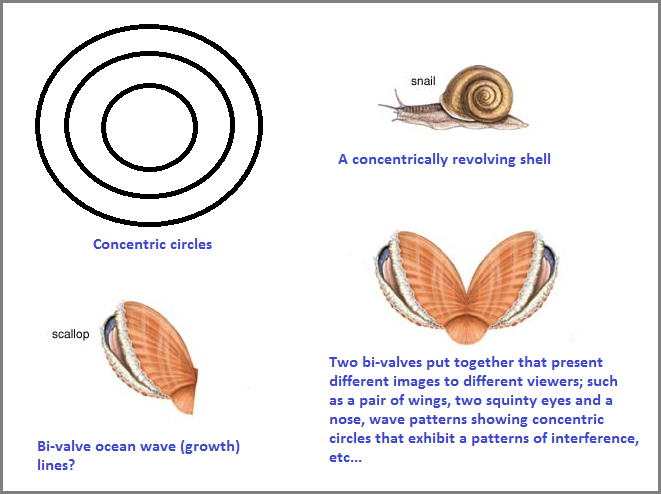
Whereas we may typically think of "concentrality" in terms of a circle with increasing and/or decreasing patterns that give the impression of inter-connectedness, we might want to think in terms of linear and triangular formulas as well. No less, let us think in terms of right and left laterality as well as the horizontal- diagonal- vertical directions, if not also from a one- two- three (+) dimensionality.
A particularly interesting representation of a one-two-three development which has not occurred, at least not in a similar fashion as the two models below, is that there is no obvious portrayal of a tri-valve.
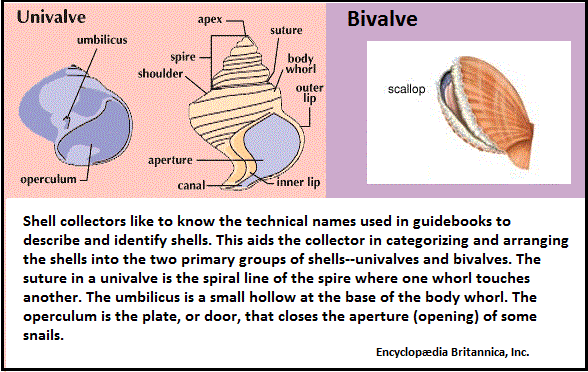
We could interpret the situation that Nature itself indulges in a conservation of number by only developing and one and two-valve system of construction for water life; or that there is a three (and possibly more) valve life-form, except that it occurs in a different formula. Then again, perhaps those who came up with the group names of these creatures chose the wrong component to focus on. By choosing what they did, these labels have forced thousands of people to do likewise... and not look at the life forms through their own eyes and label accordingly. Then again, perhaps a three-valve creature is in the making or won't come about at all because of the disintegration occurring with the planet and solar system. Nonetheless, the one and two-valve labels, when not restricted to this subject, can help us to metaphorically look upon electrical circuits as valve mechanisms.
Let's take a look at some mechanical valves. (Those familiar with electrical circuits will no doubt recall the application of electrical circuits to control valves, even though the "flow" of electricity is akin to the "flow" (volts) and "pressure" (amps) of a current of water. In a sense, electrical wires are like water hoses in which "electron-water" moves and can be directed, or "gated" for a given purpose, such as a farmer wanting to water one or another field of crops.
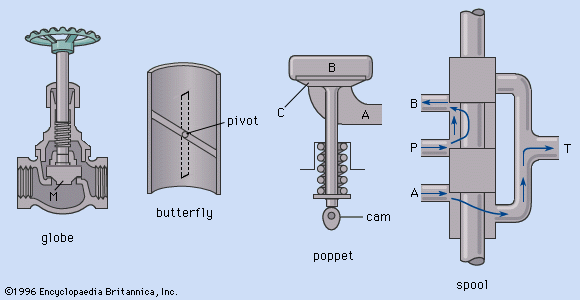
But the word "valve" can bring to mind other associations such as the valves used in the internal combustion engine and those used in the heart. Typically, we find two valves being used; one to collect and another to emit, though the words intake and exhaust may instead be used. However, such as in the case of the Wankel engine, intake and exhaust are not accomplished by valve action but by the rotation of a three-sided rotor. Thus, we have three types of automobile engines with a conventional valve setup and one without... giving us another 3-to-1 ratio. It is the same ratio we apply to the types of fuels typically used in internal combustion engines, with natural gas but a distinct alternative category, along with alcohol or some other exotic fuel not typically available for public consumption. In other words, at many a petrol (gas) station, there are three grades of gasoline with one diesel fuel oil... which is another 3-to-1 ratio. It should also be noted that airplane engines at one time used a radial arrangement of pistons, though other designs may have been experimentally attempted.
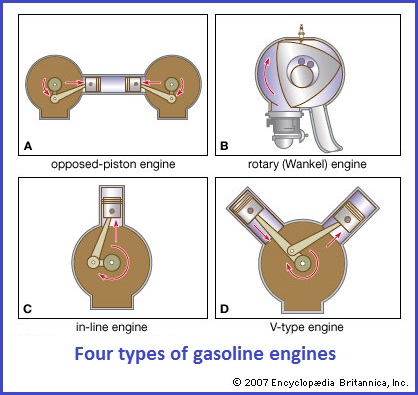 |
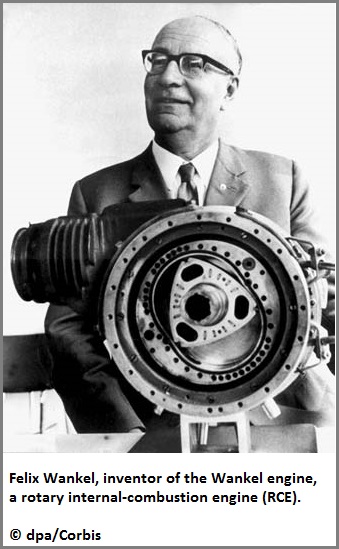
|
Along with a discussion of valves should be the introduction of engine strokes by which the valve action is necessitated.
 |
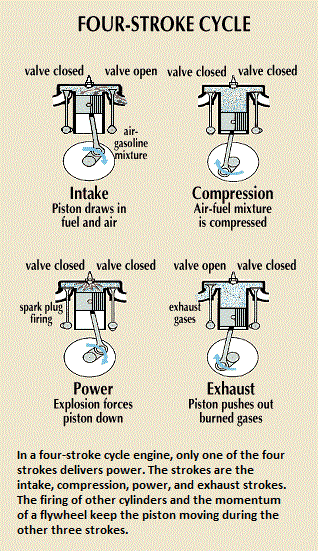 |
While the following single piston explicates the intake and exhaust, it should be noted that engines have typically used a conservative number of pistons. For example, single piston lawn mowers, generators, motorcycles, etc., two piston motorcycles, farm equipment, and automobiles, three, four, six, eight, ten, and twelve pistons in automobiles. The number of pistons is conserved, and is usually defended as a necessity based on costs of materials, weight, or application need. However, in making an analogy between intake and exhaust values coupled to strokes, let us set it next to a simple image detailing the emitter and collector "ports" of a transistor. (The base would then be a type of "stroke".)
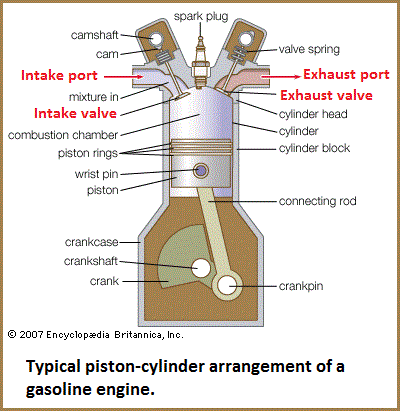 |
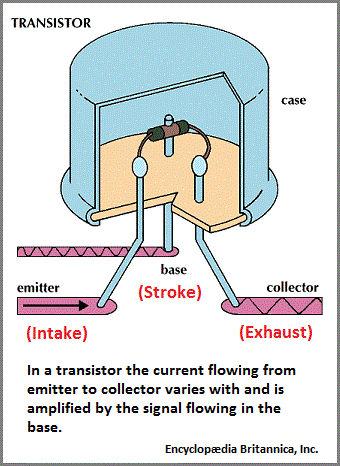 |
While some can easily picture electron flow as a flow of water, they may not alternatively view the water as fuel or a fuel/air (fuel/gas) mixture. In doing so, the materials for electronic components can be shaped to produce different flow characteristics as can be described in the following three images related to jet engines, though solid fuel rocket engines can be considered as well. (Liquid fuel is the feeding of an infant, while solid fuels are used for later development. In other words, Electronics needs to grow up so that computers can concomitantly mature.) Controlling the speed of an inlet and exhaust flow as well as what the mixture is and what the flow is to be coupled to, is crucial in determining potential speed and thus "power", which necessarily brings in the topic of inertia and inertia dampening.
 |
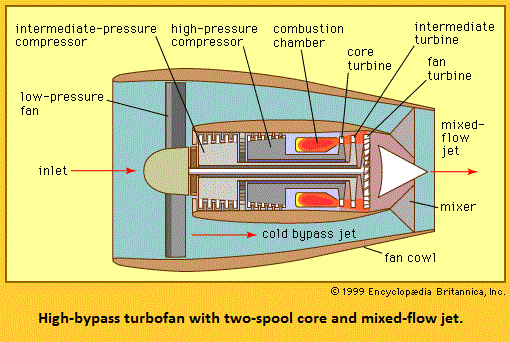 |
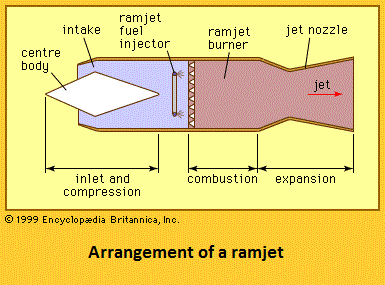 | |
In rocket engines, there is no inlet port per sey, since the fuel either carries its own means of combustion as a single component needing only a catalyst, or that the fuel and its means of combustion are held separately until power is needed by way of introducing two or more substances together. For example, in the usage of nitrous oxide to increase the power of an internal combustion engine, the nitrous carries its own oxygen within its structure, thus aiding in the burning of the added fuel without a need for metering the fuel for a correct mixture of air to be added. Though supercharging (at the intake side by way of a fan belt accessory) and turbocharging (by way of an exhaust flow) can also increase power without the usage of some other-than gasoline fuel; they are obviously not valuable if we consider the adoption of a sealed computer system to facilitate lowering component temperatures via a design utilizing a vacuumless internalization... like our body using the blood circuit to carry oxygen. While the commonly used measurement of 98.6° for body temperature is considered normal and healthful, other temperatures are deemed harmful, even though some think that living in colder or cooler climates facilitates development of intelligence because they contribute to sedentary-intellectual activities.
 |
 |
 | |
The rocket engine has a closed inlet port in terms of being externally exposed. Combustion, or "digestion" (converting fuel into energy) takes place within a "stomach" chamber. And just like a human body, there are orifices, or gates, or passageways through which both solid and liquid substances can move, and be moved by related systems of "peristalsis" (wave-like movements); though the relatedness may not be easily seen because translating one occurrence to that of another that is not familiarly similar through an adaptive analogical processing method of observation... may make such connections difficult for some to compare. Nonetheless, the presence of valves, chambers, oxygen mix and flow, are seen in the four-chamber human heart with a bicuspid (mitral) and tricuspid valve arrangement. Instead of the word "stoke" being used to describe four different sequences, the word "phases" can be adopted without stretching the contextually applied vocabulary of too many readers.
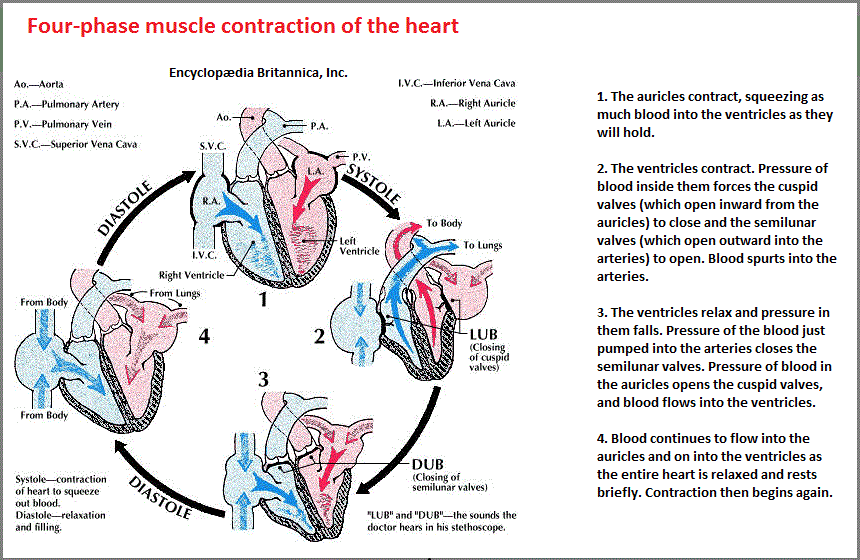
 |
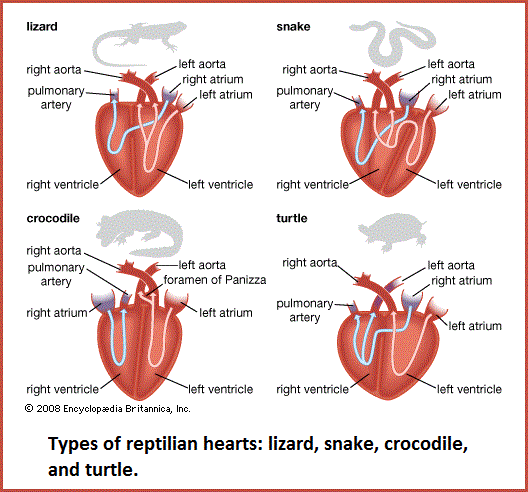 |
Subject page first Originated (saved into a folder): Thursday, November 13, 2014... 5:50 AM
Page re-Originated: Sunday, 24-Jan-2016... 08:51 AM
Initial Posting: Saturday, 13-Feb-2016... 10:59 AM
Updated Posting: Sunday, 8th- September- 2019... 5:23 AM
Herb O. Buckland
herbobuckland@hotmail.com